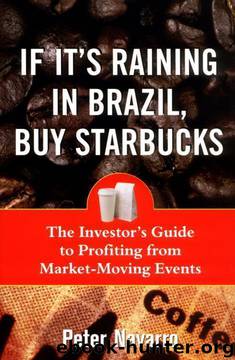If It's Raining in Brazil, Buy Starbucks by Peter Navarro

Author:Peter Navarro
Language: eng
Format: mobi
Published: 2012-06-11T09:33:00+00:00
SHOULD YOU BUY ON THE DIPS OR BUY ON THE PEAKS?
Because this point is such an important one, I want to digress briefly now and talk more about one of the great strategic debates that perennially rages in the stock picking world. This debate revolves around the issue of whether you should buy high and sell higher as Dietrich was trying to do on his breakout play or, alternatively, whether you should buy on the dips and sell on the peaks as so many bargain hunting investors attempt to do.
In fact, either strategy can make you a lot of money-or lose you a lot of money. The trick is to choose your strategy based on the appropriate market context. And that's where a macrowave perspective can be so very helpful.
Let's look at the buy-on-the-dips, sell-on-the-peaks strategy first. This can be a moneymaking strategy-but only if the stock market is in a socalled trading range. In a trading range market, stocks themselves as well as the broad market indexes tend to move up and down within a clearly identifiable range. During such a time, the buy-on-the-dip, sell-on-the-peak trader can often eke out a nice little profit exploiting cyclical movements within this range. In contrast, in a trending market, both stocks and the broader market indexes will continue to exhibit cyclical price movements. However, in addition to those daily movements, there is a weekly or monthly upward or downward movement in the overall market. In this kind of trending market, the buy-low, sell-high investor can get absolutely killed for two reasons.
First, the only stocks that will keep finding their support levels or lows are the ones that are most likely to go against the trend and dip further. In other words, buying on the dips in an upward-trending market is a perfect recipe for picking losers. Second, and even worse, selling at the peaks in an upward-trending market is to miss the real meat of a profit move when a stock breaks through its existing resistance level, trends upward with the broad market trend, and finds a new peak. In this scenario, the buy-low, sell-high investor winds up violating one of the most important principles of macrowave investing, which is to let your profits run.
Now what about Dietrich's buy-high-and-sell-higher approach? This strategy is predicated on a so-called stock breakout. Such a breakout can occur when a stock finally bumps through an area of resistance and reaches a new high, while a breakdown occurs when a stock finally falls through a level of support and reaches a new low. Technical traders like Dietrich love to go long on such breakouts and sell short on the breakdowns because once a stock finally does break free of its support or resistance chains, it is likely to enjoy a strong move. Indeed, this buy-high, sell-higher philosophy is one of the important linchpins of the Investor's Business Daily approach to investing which is followed by millions of investors.
Download
This site does not store any files on its server. We only index and link to content provided by other sites. Please contact the content providers to delete copyright contents if any and email us, we'll remove relevant links or contents immediately.
Rich Dad Poor Dad by Robert T. Kiyosaki(6196)
Pioneering Portfolio Management by David F. Swensen(6092)
How To Win Friends and Influence People by Dale Carnegie(4342)
The Money Culture by Michael Lewis(3860)
The Dhandho Investor by Mohnish Pabrai(3574)
The Wisdom of Finance by Mihir Desai(3539)
Liar's Poker by Michael Lewis(3232)
The Intelligent Investor by Benjamin Graham Jason Zweig(2940)
The ONE Thing by Gary Keller(2925)
Mastering Bitcoin: Programming the Open Blockchain by Andreas M. Antonopoulos(2902)
Fooled by Randomness: The Hidden Role of Chance in Life and in the Markets by Nassim Nicholas Taleb(2872)
Rich Dad Poor Dad: What The Rich Teach Their Kids About Money - That The Poor And Middle Class Do Not! by Robert T. Kiyosaki(2842)
Investing For Dummies by Eric Tyson(2804)
How to Win Friends and Influence People by Dale Carnegie(2801)
How to Day Trade for a Living: Tools, Tactics, Money Management, Discipline and Trading Psychology by Andrew Aziz(2792)
Market Wizards by Jack D. Schwager(2549)
Zero Hour by Harry S. Dent Jr. & Andrew Pancholi(2541)
How to Pay Zero Taxes, 2018 by Jeff A. Schnepper(2508)
Rich Dad's Guide to Investing by Robert T. Kiyosaki(2418)
